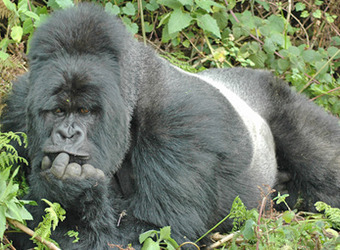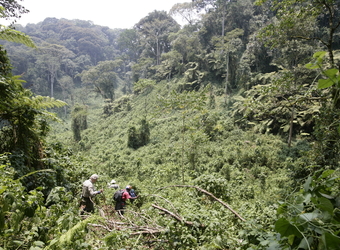Bwindi National Park
| Read Reviews | Write a Review Start Planning Your Custom Safari
 view larger image
view larger image
Named for the dense forests it encompasses, Bwindi Impenetrable National Park is home to roughly half the world’s remaining mountain gorillas. Though the park is best known for its outstanding gorilla tracking, it also provides refuge to chimpanzees, monkeys, elephants and various small antelope. Bwindi is a key Uganda birding destination, with 23 of Uganda’s 24 Albertine Rift endemics, including threatened species such as African green broadbill and Shelley's crimson wing.
 view image gallery
view image gallery
The Safari Experience
Early morning gorilla treks are the highlight of Bwindi for guests 15 years and older. In a group of eight guests, journey into the dense, green primary forest. Local guides and trackers cut a path and pursue evidence of the gorillas to locate them. The gorillas in Bwindi are known to move farther in a day than those in Rwanda, often resulting in longer treks. Finding the gorillas can take anywhere from 15 minutes to several hours, if they have been on the move, and our trek may involve climbing to altitudes up to 7,500 feet. The terrain is rough and at times muddy, though the rewards are profound. The beauty of the forest and surrounding scenery make it worthwhile, even en route. Once the gorillas are located, one hour is spent with them, often described by our guests as the most profound natural nature experience they have ever had.
 view image gallery
view image gallery
Wildlife
The mountain gorilla is one of two sub-species of eastern gorilla, and the most critically endangered with a total population of about 1,004 living between Rwanda, Uganda and the Democratic Republic of Congo. These very social creatures are typically found in groups averaging 10 individuals, ranging from five to 30 individuals in any one family. The gorillas here feature slightly different behavior than those in Rwanda: they eat more fruit, are more prone to climb trees to find food, and often build nests in small Echizogwa trees. There are presently 19 gorilla families in Bwindi, limiting permits to about 152 per day. In addition to the gorillas, Bwindi is home to a diversity of wildlife including, to name a few, colobus monkeys, chimpanzees, and eight other primate species, elephant, giant forest hog, African golden cat and African civet. There are an estimated 120 mammals, 350 bird species and over 200 species of butterfly.
 view image gallery
view image gallery
How to Include Bwindi in Your Safari Itinerary
Recommended Number of Nights
Nature Travelers: 3 nights
Photographers: 3 nights
Families: 3 nights
Active Travelers: 3 nights
Other Regions to Include
A well-rounded Uganda trip may include peering over Murchison Falls on the Victoria Nile, viewing chimpanzee and 12 other primates in Kibale Forest, seeing elephant, grazing buffalo and the hippo-filled Kazinga Channel in Queen Elizabeth National Park, and observing zebras and large eland antelope in Lake Mburo National Park. Bwindi can also stand-alone as a gorilla-focused extension to any classic Kenya or Tanzania wildlife safari, featuring key wildlife viewing areas such as the Serengeti or Maasai Mara for the great wildebeest migration, Laikipia for varied species of giraffe and zebra as well as black and white rhinoceros, and the Ngorongoro Crater for its iconic menagerie of over 25,000 mammals. From Uganda, extend to Zanzibar to experience the rich history and culture, lie on the beach and spot the Zanzibar red colobus monkey in Jozani Forest.
